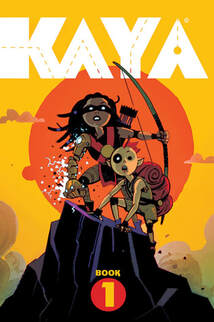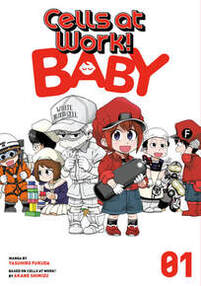
Illustrated by Wes Craig, colored by Jason Wordie, lettered by Tom Napolitano
After their village and civilization is destroyed, Kaya is tasked by her dying uncle to take her half-brother, Jin, across the world to Monk Islands. There, he will be safe and be able to communicate with the gods and gain his promised powers. Once he comes into his own, he will be powerful enough to destroy the evil Atrian Empire and restore humanity to glory. But along the way, Kaya reunites with a childhood friend and supposed betrothed, Seth of the Lizard Riders. They’ve been tasked with killing a fierce beast, the Magron, and could use Kaya’s strength and magical arm. Jin despises the detour, but the money could bring them much needed supplies, as long as they survive the fight and aren't betrayed along the way.
0 Comments

Illustrated by Issei Hatsuyoshiya
Rookie Red Blood Cell navigates through an adult male body, struggling to get his job done in an environment of high stress, skinny arteries, and with foreign toxins constantly being introduced. When the body introduces carbon monoxide, several red blood cells are injured and disfigured as it binds to them and forces them to drop their shipments of oxygen. Later, the Red Blood Cells are sprayed with alcohol, and they take a detour through the liver to have the alcohol cleaned off them. Miss White Blood Cell has her work cut out for her battling against a weak environment that invited in pneumonia and gonorrhea bacteria. 
In this blend of historical and scientific perspective, Fetter-Vorm explores the race between several countries to create the Atom Bomb, starting with the theoretical exploration of splitting atoms, to the realization of the theory under the Manhattan Project. Fetter-Vorm particularly focuses on the American efforts, so there is little detail from other countries involved in the race. The beginning of the novel focuses heavily on the science behind how it's possible to split an atom and what happens on a molecular level. The historical perspective is sprinkled throughout this section, but really becomes the major focus during the second half of the book. Particular attention is given to Oppenheimer and General Leslie Groves as the leaders of the project. Fetter-Vorm also goes into quite a bit of detail about the dropping of Little Boy, the Uranium atom bomb, and Fat Man, the plutonium atom bomb, on Hiroshima and Nagasaki, respectively, and how each of the different types of atomic bombs' explosions affected the cities and people.

Red Blood Cell-san is determined to make it around the entire respiratory system without the help of other cells. After numerous times getting lost and having a guardian angel in White Blood Cell-san help her from the shadows, she finally makes it all the way around for one cycle! Then, we go to a different cell who is in his apartment, dividing himself to make another cell. He finds another cell who is playing practical jokes on white blood cells and Killer T cells. The practical joker turns out to be a rhinovirus, wanting to infect all the cells and cause the Cold. Later, White Blood Cell-san fights tirelessly to help the cells of a hair follicle fight off the bacteria that causes acne. Lots of other white blood cells have tried and failed, but White Blood Cell-san isn’t a quitter!

This spin off of the main story of Cells at Work is about a baby body with baby cells, and all of them are drawn in a chibi style (large eyes, puffy cheeks, short limbs). The main characters in this are Red Blood Cell (Chibi) and F, a type of red blood cell bearing Hemoglobin-F which is more effective when the fetus is in the womb. By the end of this volume, we also meet a White Blood Cell (Chibi), who, unlike his counterpart in the main series, is a big scaredy cat but still does his job in defending the baby’s body. The baby cells must fight off infection, with some help from Mother's Milk, as well as figure out how to navigate to the lungs once the baby is born.

In the beginning, there was the World Flower, spouting planets and stars into existence like pollen. On one of these planets (Earth) is the hive in which we find ourselves. In it, Dvorah is capping the cell of young larva Nyuki, who is scared of metamorphosis and what the rest of life will mean for her. After metamorphosis, Nyuki emerges as an adult bee but is rather scared of the outside world. That is going to work out poorly because there is a new queen in the colony, which means the old queen must lead some of the colony away to a new site. Dvorah is going, and Nyuki must decide. It turns out, Nyuki loves flying, but there are many perils of the outside world, including praying mantis, spiders, and birds! As Nyuki grows up, she finds a special flower with the best nectar and helps cross-pollinate it with a flower across the field. Nyuki inspires a younger forager, Melissa, to become a great forager for the colony.

The cells are still hard at work, this time against a few different attackers. First, the blood cells have to fight off food poisoning from bacteria but also a tape worm hidden inside sushi, and it threatens to break through the stomach wall! Next, the body undergoes heat stress, which makes it difficult to fight off bacteria, especially ones that have their own heat protection. Red Blood Cell gets lost on a delivery (again) and finds herself in the Bone Marrow where red and white blood cells are nurtured through their young lives before they become mature red or white blood cells. This detour takes Red Blood Cell down memory lane, to her own upbringing. Lastly, the immune system must fight off the deadly, mutated cancer cells that trick the body into bringing it nutrients so it can multiply faster.

Illustrated by Boichi
Kohaku and Senku take the warm spring water back to Kohaku’s sister, and it turns out she lives in an entire village of around 40 adults! The guards bar Senku from entering - no outsiders are allowed, rules are rules. But Kohaku’s sister, Ruri, might know some things about the time before stone! Senku meets Chrome, another science-minded person, and he wins him over in a battle of wits. This gives Senku access to all of Chrome's vast stores of elemental supplies. Senku is determined to win over the villagers and enlists some of them in making antibiotics to cure Ruri’s sickness. That way, they’re sure to let him in the village and he can figure out how she knows so much. 
This latest installment in History Comics presents the events leading up to and including the accident of the Challenger. This is done through a group of four students and their teacher, set 400 years into the future, where the students are tasked with a history report on Challenger Day, a holiday commemorating the lives lost during the space craft's explosion. The narrative is comprised of four parts: history of the space program, where particular attention is placed on the Space Shuttle program in particular; the history of Challenger crew, where each member shares their biographical information through the use of AR technology in the students' classroom; the accident itself, presented by the teacher and given all due gravitas; and the Rogers Commission, told largely by Richard Feynman through AR again.

Illustrated by Andy Ristaino
In this entry of Science Comics, artist and writer attempt to break down a complicated system and explain it with clever illustrations, narrated by bacteria found throughout the digestive system. Readers are taken through the major areas of digestion: the mouth, esophagus, stomach, small intestine, large intestine, and the rectum. Other organs discussed are the liver, gallbladder, pancreas, and appendix. Vomit, burping, and farting are also explained as products and necessary functions of digestion. |
About MeI've been reading manga and comicbooks for years. Now, I write reviews and other helpful things for School Librarians, teachers, parents, and students. Search this siteRatings, Audience, and Subject Tags
All
Archives
July 2024
|




